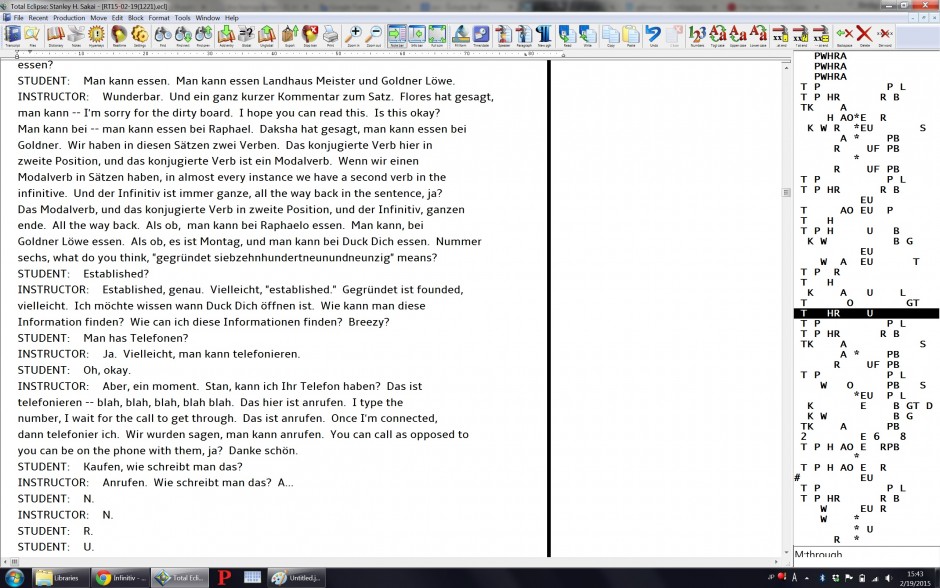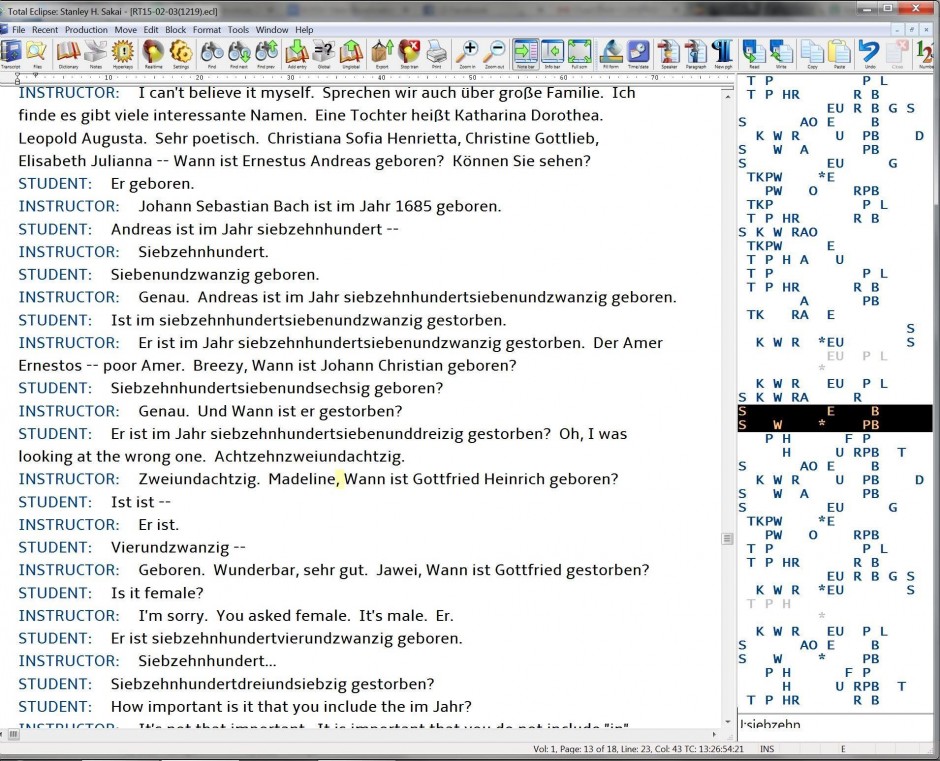Hey! Sorry for the lack of updates. But I wanted to share a new video I just made about how steno works for those who still don’t know. I wanted to make a very quick video that summed up all the main points in a way that was short and to the point so one of my students could use it for a class project about what it’s like in the day of a deaf person. Enjoy!
Tag: steno
A Different Kind of Steno Hell: German
If you’ve missed the blatantly self-promotional vomit I’ve been unabashedly spewing all over Jade’s Stenoquery and on my own social media pages, you might not have known that I have accepted quite the unique challenge this semester: Captioning a semester-long intensive German class. I feel like I can barely manage to pull my head out of my ass when writing English realtime, but GERMAN?! HOW DO YOU EVEN? Besides not speaking the language at all prior to starting the class, stenoing a language class as opposed to a monolingual foreign language environment presents a number of unique problems that compound on the scads of details that we stenos are constantly juggling with in our heads whilst taking down just one language.
Let me explain why this situation is, without exaggeration, a venerable shitshow.

1. Language classes are bilingual environments.
You’re dealing with two sets of vocabularies and trying to prevent their corresponding dictionaries from overlapping because you constantly need access to the entirety of each at all times. You might be tempted to assign EUBG for “ich” but that’s your -ic. Sie and sie? Well, SAOE is “see” and SAO*E is “sea.” ES can’t be “es” because ES is “he is.” TKU can’t be “du” because it’s “did you.” The list goes on and on. How the hell do you brief anything? If you’re a brief heavy writer like I am, pretty much all simple strokes are used up, including those containing the asterisk. What is one to do? I guess I don’t have that many strokes containing the number bar.
Solution: NUMBER BAR IT IS. Thus, ich = #EU, ich bin = #EUB, du = #2KU, sie = #150E, Sie = #150*E, etc. Thankfully if it’s multistroke, the German entry will seldom conflict with an English entry so for those you can just write them normally. TKPWE/SEUBGT for Gesicht won’t really conflict with anything in English. Nor will PHAOURT/HREURBG/SAOEUTS for mütterlicherseits.
Sometimes, I just define the English outline for certain words that look enough like English and mean the same thing in German, which, consequently means that while I’m writing, random German words sometimes pop up. But since they look enough like their English counterparts, I don’t worry about it being confusing. It just looks kinda ugly having English text with random capitalized nouns and German here and there: “I have a nice Präsentation for you today. But before that, kann you all turn in your completed Handouts?” But you can only do so much, ja?
2. Special characters.
It’s logical to expect heavy reliance on fingerspelling in a foreign language class but what if the word contains a vowel with an umlaut or the eszett (ß)? These letters make important morphological distinctions in German. “Bruder” is just one brother but “Brüder” is plural. Es gibt hier ein Apfel aber ich kann noch drei Äpfel in meiner Tasche haben (There is an apple here but I can have three more apples in my bag). You can’t just stick in the non-umlauted version because many words differentiate themselves solely by the presence of the two dots.
Solution: Make additional fingerspelling letters using some random ass combination of letters. I chose STK* for no reason at all. Thus, STKA* = ä, STKO* = ö, STK*E = ë, STK*U = ü, STK*S = ß, STKO*EU = äu.
3. German phonology doesn’t necessarily map neatly to what we have available on the American steno keyboard.
There are many ways in which German does not “fit” on the English-derived steno keyboard.
- German has more vowels than English and many words are minimal pairs based on a vowel sound alone. Bruder/Brüder, schon/schön only differ by the raised vowel but some differ by a vowel and maybe something else attached to the end: Zahn/Zähne, Satz/Sätze. English steno theories do not have ways to handle these.
Solution: Reassign English steno combos to German values. Thus, AOU -> ü (Bruder = PWRURD, Brüder = PWRAOURD). AE -> ä (Satz = SATS, Sätze = SAETS). OE -> ö (schon = SHOPB, schön = SHOEPB).
- German contains certain consonant combos that don’t exist in English: schreiben, schlappen schneit, schwarz.
Solution: Again, make some shit up. SKHR- = schr-/schl-, SKPH- = schn-, SW- = schw-. Thus, SKHRAOEUB = schreib-, SKHRAP = schlap-, SKHRAF = schlaf, SKPHAOEUT = schneit, SWARZ = schwarz.
*I haven’t yet found an instance where having both schr- and schl- represented as SKHR- would create conflict.
- German morphemes don’t look like English ones, which makes tucking endings and such impossible using conventional English steno theory (The most common endings are not -ing, -ed, and -s/es so you can’t just throw those in intuitively for inflected forms). This fact makes writing German on an English steno machine incredibly sucky because PRACTICALLY EVERYFUCKINGTHING in German has mutable endings or vowels carrying fake IDs.

So how do you avoid having to come back for every damn inflection of a word?
Solution: Assign new values to final consonants that would serve as tucked endings in English. -DZ = -en, -Z = -e, -SZ = -es, -T = -t, *S = –st. Why -Z for -e? Jacked that shit straight from German steno. Thus, HABDZ = hab + en -> haben. SAGDZ = sag + en -> sagen. TRAGZ = trage. TKPWHRAUBZ = glaube. TKPWHRAUBDZ = glauben. If -Z doesn’t “fit” when adding -e, throw in * instead. So dachte becomes TKA*BGT, brachte becomes PWRA*BGT because you can’t fit BGT and -Z in the same stroke, obvs.
But you can have fun with this like in English. Make up a bunch of arbitrary shit that adds endings or phrases if it’s included in a stroke. Like, I’ve made the -Z into an x + Sie phrase ender. So haben Sie becomes HAEBZ, stehen Sie becomes STA*EUPBZ, können Sie becomes KO*EPBZ. -FB and -FT add the accompanying conjugations of haben in certain phrases. Ich habe -> EUFB, wir haben -> WEUFB, sie hat, er hat -> SWRAOEFT, EFT.
- Condensing syllables.
The reason there’s an asterisk in stehen Sie and können Sie in the above examples of phrasing is because it means I’ve “skipped” a syllable. So, like, kön-nen is KÖN and ste-hen (which is pronounced more like “shtay-hun”) is STAIN. I don’t really have a nice, concise system yet but for now I use * sometimes to condense two syllables, one of which contains a stressed syllable followed by an unstressed schwa-sounding one.
Stehen -> STA*EUPB, können -> KO*EPB, sehen -> SA*EUPB, gehen -> TKPWA*EUPB.
3. Capitalization.
German capitalizes all nouns. Ein Gewitter is “a thunderstorm” while es gewittert means “it is thunderstorming.” Sometimes a noun and a verb stem look the same. Sie fragen means “you ask” but haben Sie Fragen? means “do you have questions?” So every time I write TPRAG, which I’ve defined as “frag-,” I have to take a split second to ask myself whether in this context, it is a noun or a verb to decide if I should hit KPA (cap next) right before.
Say a normally capitalized noun is combined into some compound — yeah, it’s no longer capitalized if it’s not the first word in said compound. “The restaurant” should be written das Restaurant but if you want to say “my favorite restaurant is,” it takes on the prefix Lieblings-. Hence, mein Lieblingsrestaurant ist would be the German equivalent.
This becomes a problem if, say, you’ve made a handy prefix HRAOEBLS for Lieblings-. Eclipse doesn’t have a “force next word to lowercase” command so if you just write having defined RAURPBT as “Restaurant,” you get LieblingsRestaurant — wrong.
Solution: Define everything that’s a compound. Fingerspell like a mothafucka. Define certain things that are commonly said as non-nouns lowercase, that way you can just throw your cap next stroke in before it to make it look right. But the trick is remembering to every-goddamn-time.

4. Not knowing the language.
Most anglophone stenos will tell you (usually with a characteristic balls-out, no-shame, pedantic/elitist/prescriptivist flair — note to U.S. court reporters: Please stop) how crucial having a vast vocabulary is when taking down English speech. Well, lucky you because your English is pretty on point, yeah? Too bad it means koala shit in this context. Of course there will be certain frequently used words and phrases that overlap with English (Think: Schadenfreude, Zeitgeist, gesundheit, etc.), but for the most part, German phonology and syntax differ enough that having an exquisitely developed ear for English will help nichts bis sehr wenig when writing German steno, or any other language steno for that matter.
I have a fairly extensive linguistic background. I graduated from UW with a degree in Linguistics, speak three languages fluently, and have studied four others to varying degrees but German is not one of them. I speak intermediate level Dutch, which I’ve come to learn, resembles German a great deal more than English. It may sound like I’m bragging but all of this, surprisingly, makes little difference. It’s still hard af. For all intents and purposes, I’m as much a beginner as most of the other students in class. The class is mostly taught in German. While the other students can sit there clueless when the teacher says something unfamiliar, I have to get something down. While the others can use class time to practice new words and phrases, I have to have them mastered by the very next time the teacher utters them. I have to constantly draw upon my linguistic knowledge and combine it with what I can infer based on my cute repertoire of German to approximate spellings for the relentless barrage of words I’ve never heard before. I feel constantly under pressure to stay 10 steps ahead everyone else through intense self-study and/or keeping my phone unlocked with Google Translate up at all times.

One of the ways being a learner has become most painfully apparent is when attempting to accurately transcribe German declensions. If you don’t know what declension (also known as “cases”) is, it’s basically a way certain languages handle grammatical roles in sentences. While analytic languages like English or Chinese rely heavily on word order to convey who does what to whom in a sentence whilst leaving most of the superficial aspects of the words alone (their sound and spelling). Synthetic languages like German tend to do this by forcing you to solve a timed Rubik’s cube every time you hit a noun. Run out of time? Congratulations, you sound like an idiot. English has remnants of a more case-heavy past in the form of subject vs. object pronoun pairs: He/him, she/her, I/me. Well, German has three genders, two numbers, and four cases. So at minimum, an article will generally have 16 forms. Some look the same superficially but serve different functions. The masculine nominative der (the) is the same as the genitive plural — der! It makes word order relatively free compared to English but the drawback is that trying to compose a simple phrase in German is bit like attempting to haul all 20 of your rabid feral cats in a red wagon across a busy intersection.

Sie trägt den Pullover
- SWRAOE/TRAEGT/TKEPB/PHROUFR
- She is wearing the sweater.
Der Pullover ist grün
- TKER/PHROUFR/KWR*EUS/TKPWRAOUPB
- The sweater is green.
Ich habe einen Hund in meinem Haus
- EUFB/OEUPBD/HUPBD/TPH/PHOEUPL/HAUS **maybe make TPH*PLD in meinem??
- I have a dog in my house.
Mein Hund ist im (in + den = im) Haus
- PHOEUPB/HUPBD/KWR*EUS/KWREUPL/HAUS
- My dog is in the house.
Das ist ein Haus
- TKAS/OEUPB/HAUS
- That is a house.
Wofür interessieren Sie sich?
- WAOUFR/SPW*/SAOERPB/SWRAO*E/SEUFP
- What are you interested in?
Woher kommst du?
- WOER/KO*PLTS/#2KU
- Where are you from?
Ich komme aus Seattle.
- #EU/KPHA*US/SAOELGTS **Notice I phrased komme aus as KPHA*US. The * is supposed to stand for the -e in komme.
- I come from Seattle.
The bolded portions of the above examples are to point out the various forms words like “the,” “a/an,” “my,” and “you” take in German. The last example is to illustrate how I applied both phrasing and inflectional principles into a single stroke.
On top of that, Germanic languages tend to stress the first syllable so a lot of times, unless a phrase is uttered very carefully, it’s hard to tell the difference between eine, einer, einen, einem, deine, deiner, deinem, kein, keine, keiner, keinen, keinem because the first syllable gets the stress and the rest goes straight to schwablivion.
Q. So what does all this amount to?


A. Some ridiculous fucking crazy shit.
The end. Tschüss (STAOUS)!
By Popular Demand: How I Got Into Stenography
This post was originally my response to an email I received regarding teaching oneself steno. I figured it was about time I write the whole story in one place so I can stop telling the same story over and over again and also because I owe Mirabai my “How Plover Ignited My Career in Professional Stenography” article I’ve promised her for, I think, two years now. 😛
The original email asked:
I’m really interested in learning to caption, and would like to hear how you taught yourself because I could sure skip the $$$ of court reporting school/courses at this point in my life. I also have a linguistics background and wonder how much that might help? How much time did you spend at it, etc.
My response:
I’m glad you are looking into teaching yourself steno. I am currently mentoring a friend who lives near me in learning machine shorthand. She, too, recently acquired a machine and wants to teach herself.
Getting Started/Plover
I started my journey learning stenography by teaching myself Gregg shorthand in university and got really fast at it in a very short amount of time. This was strictly for the purpose of keeping up with instructors in class when taking notes. When I took computer programming, there were actually multiple deaf students in the class because it was for the Summer Academy, a sort of grant-funded scholarship sort of program whereby the UW will let deaf or hard of hearing students take classes for free at UW related to tech and engineering. We had a captioner in every class hooked up to a projector and for the longest time I was in awe and had no idea how the system worked until I finally went up to the prof and asked how in the world could every word he uttered in class (along with every word uttered by the students in the class) go up in real-time on the screen.
“She’s doing it,” the professor says while glancing at the little lady sitting at the front I hadn’t noticed until then. She had a very strange-looking keyboard on her lap and I was fascinated, watching her effortlessly make a few taps that would expand into entire sentences at lightning speed on the screen. I eventually went up to her and asked how she operated that machine. So she then goes into machine shorthand and asks me if I’ve ever heard of pen shorthand. I don’t think she expected me to know what it was much less witness me whip out my notebook covered in Gregg and boast I could spit it out at 110 WPM after a couple months of self-study. She told me what she’s doing is just like Gregg and from that point on, I wanted to know more. I researched and found Glen’s website and Plover, a free, open-source stenography software that lets you steno using a gaming keyboard created by a brilliant team consisting of my stenographer friend and colleague in NYC, Mirabai Knight and software developers, Joshua Lifton and Hesky Fisher. As soon as I learned enough to get a few words up on the screen, it was all downhill from there (or “uphill?”) and I kept practicing on the gaming keyboard for fun and looking up any words I didn’t know how to steno in Mirabai’s stock dictionary.
Acquiring Professional Equipment and Software
I soon got my own Gemini machine from eBay for about 100 bucks and started practicing. I used it for everything – taking notes in class (yes, I lugged it around with me) to just playing around, listening to the TV, getting down as much as I could. At that point, I had downloaded DigitalCAT, a proprietary CR software whose company, Stenovations, offers freely for use by students of stenography. I would divide my time between ling classes and trying to incorporate steno into my routine as much as possible (writing essays, emails, etc.).
Steno Theory
Stenovations has a variety of starter dictionaries for download on their download page. I started with StenED as it was a theory I had seen mentioned online all the time, but quickly learned how stroke intensive it was. I switched to Phoenix, characterized by its vowel omission principle, the fact that all schwas were written with “U,” and its overall strict adherence to phonetic rules because in my mind, it seemed logical and facilitated “less thinking and more doing.” Well, that did turn out to be the case but not necessarily in a positive way. It was way too clunky and laborious for me. Having to write everything out in 3-4 strokes gets old fast. Granted, I could’ve just refined and modified Phoenix like some of my colleagues have to make it more efficient and usable (Jade King being a notable example), but in the end, I personally didn’t like it. And since I’m the only one who will be writing whatever theory I learn for the length of my career, to hell with it. So I scrapped it altogether.
FYI:
- Vowel omission principle: You omit vowels in sequential multi-stroke words, the idea being that it’s one less thing to worry about. So a word like “inhospitable” would be written something like TPH/HOS/P-T/-BL instead of TPH/HOS/PEUT/*ABL or something.
- Schwas written as U: Vowels that are unstressed are typically pronounced as an indistinct schwa sound in English. If you have to stop for a second to remember the spelling of a word, it might cause you to hesitate. By writing ALL schwas as U, you no longer have to worry about the exact identities of the vowels on the fly as in other more commonly orthography-based theories.
I finally switched to Philly Clinic Theory ’cause I heard it’s what Mark K. wrote before he, through his interpretation of it, made it into Magnum. Now, I write a combo of both Philly and Magnum but they draw on each other because Magnum is basically the principles of Philly modified somewhat and cracked out on briefs. Since I learned Philly, I often find that when I think of a brief for something and check Mark’s Magnum dictionary to see what he uses, I find we come up with the same answer independently all the time. But a lot of people tell me I “think” like Mark so it could be that. But based on my own introspect, I know I can memorize arbitrary sound combos (and movements as is the case when I started learning ASL) with ease and assign them meaning. I very seldom need a mnemonic or memory trick to make it stick. I say a lot of my being able to subconsciously remember thousands of briefs with little effort comes from my experience in being/trying to maintain (my status as) a polyglot having honed my brain to that kind of thinking for practically my entire life.
As far as Phoenix goes, I don’t like it. I like very short, efficient theories like Philly Clinic, or Magnum. I don’t know how your brain works, but like I said, I know how mine does. I can make random briefs here and there, do them once or twice during a job, and remember them all correctly at speeds upwards of 280 words per minute a year later. There’s no secret to that, either; it just happens for me. If it doesn’t for you, then you should consider maybe learning a longer theory with less of a memory load. I’m saying this with the assumption in mind that you don’t want to take forever before you start working.
A linguistic background may help you in that you were probably taught to be more descriptive and not as prescriptive like 99.99% of CRs are. I feel I spend less time agonizing over why somebody keeps using this verb wrong or doesn’t use the subjunctive than most other reporters because I don’t care. As such, I do not correct speakers when I write their speech. I only care about accurately portraying their utterances in text form, not whether or not it is correct prescriptive American English. I think being a polyglot or bilingual would help much more, especially for when you hear random words that are not English. A ling background also helps when I hear “post-alveolar affricate” in a ling class, but I know that wasn’t your question. It might also help you find patterns in how theories smoosh words, or syllables rather, into the rather small phonetic/phonemic template you have to work with on the steno machine.
As far as equipment all you really need is a machine that can output to a computer, either by serial connection, USB, or some other protocol. I mostly input my steno via Bluetooth at all times currently. Also, you will need some CAT software. CAT stands for computer-aided translation. It’s the program you run on your computer that takes the the steno input, compares it against your dictionary(ies), and outputs the text on the screen. You can use Plover as you’re starting out. Though, it’s grown to become quite powerful now, and I actually use it on some jobs where Eclipse would be too slow, or somehow otherwise unsuitable for the task. I foresee it becoming sophisticated enough to be used professionally all the time in the near future. There’s a job for which I’ve used Plover exclusively because their captioning system is not very good and requires the user to input the text directly into a box in a web browser and to press the enter key every line or so. Eclipse tends to be very slow at outputting to Windows and also formats things in strange, unpredictable ways when using its text output feature so I always go with Plover. In the future, I’ll probably be using Plover exclusively as professional software once it gains a couple key features.
Advice For Teaching Oneself Steno
The only advice that I can really give you is find as many ways to incorporate steno into what you do every day. People often ask me how I learned so fast, and how I was able to do it even though there are hundreds of steno students still in school for years and years while I step up to an invite to attempt the Guinness at the NCRA Convention after having only three years of experience from start to present learning/practicing stenography. I never took theory so basically I looked under “Stenotype” on Wikipedia and taught myself the substitution combos from their list and just found the stock dictionary off of DigitalCAT’s website and one-by-one went, “How do you write ‘rabbit’ in steno?” Or “couch,” or “chair,” or, “girder,” or “cell,” or, “chapel.” I kept doing that until I saw patterns and it all fell together in place. Also, I did quite a bit of poking around in my CAT software, just to see, “Ooh, what does this button do?” After that, it’s all about meticulous homing in on what your weaknesses are, and practicing the shit out of them, going through your dictionary and adding entries that you’re unsure if you have have or not. But most important is to keep practicing, practicing, practicing, and never giving up. Getting angry that something in a passage tripped you up, practicing it and/or briefing it, and coming back and killing it. Do that enough and you get good very fast. The biggest fault I see in today’s court reporting education is its seemingly complete inability to equip their students with the tools necessary to evaluate their own progress. CR students constantly ask others what they’re doing wrong, asking whether what they’re doing is right, when the answers lie right there in their steno notes. You just have to rifle through and find for yourself what you’re doing right and what you’re screwing up. Yeah, it sucks to have to go back and figure out what exactly you got wrong, compare your transcript to what it’s supposed to be, and rote drill the living crap out of whatever it was you got wrong. But it’s the only way. Again, there is no secret. Or maybe it’s the students themselves, I don’t know. But what I do know is far too many bash away at the machine doing the same thing over and over thinking that they’re going to get far through sheer amount of time racked up behind the machine. Not true.
Some instrumentalists end up playing in Carnegie Hall, while most of them either don’t have the discipline necessary, don’t want to put in the effort, or don’t have the right innate talent. Even for those who truly, truly WANT to do steno or play an instrument professionally, they may not possess the willpower that matches their desire to cross the finish line, however burning it may be. Some may put in the same amount of hours but never achieve the level of refinement of Mr. Carnegie Concert Cellist over here simply because he/she is not naturally suited for music. Life isn’t fair. Moreover, it could be any combination of the reasons I mentioned above that bar most players from attaining concert status (or in our case, from becoming professional, realtime stenographers) plus a myriad of other possible just “life” circumstances so it’s hard to answer the question why certain people progress faster than others.
So many people ask me, “What was your secret?” “What was your regimen?” “How did you practice?” “How many times a day did you practice?” ” How many hours did you practice?” I say, “2-4 hours a day maybe? Sometimes up to 12 hours?” “I don’t know, sometimes less.” “Sometimes, I didn’t practice at all.” “Most of the time I practiced to random shit I found on the Internet.” Then they’re confused ’cause to them it doesn’t make sense that someone who, in their eyes has achieved a great deal can be so unstructured and la-de-da. It’s because I’ve learned to find the exact things I need to work on, and work on them. If I’m already writing pretty cleanly at 180, why the hell would I keep doing takes at 180 for “accuracy?” I’m going to take that 190, 200, 225 head-on and kick it in the shins as hard as I can even though I’m still a foot too short. My time is limited. There are too many EDM festivals to go to, too many cities and lights to see, too many people to meet out there for me to sit here and waste away my numbered mortal hours being pre-employable.
But what if I have a husband? Or a Dog? Or children? Or a fulltime job?
Also, I remind people that they have to take into account that I’m not married, I don’t have children, I lived at home with my parents while I was practicing to become certified, and had no other job besides to practice. I believe that contributed greatly to the speed with which I went pro. People ask me what I would have done if I had children, or a job, or a house mortgage to pay, or whatever. I say, I don’t know because right now, I live in a studio apartment in the middle of the city by myself, and am living a pretty 20s sort of lifestyle.
I’ve never had that lifestyle, and I probably won’t have it for a long time. I knew going in that I had the time and the resources to be able to do this both intellectually and materially. Some people go in, and complain that they don’t have enough time to get in their practice because of husband, familial obligations, and “stuff.” So many students are begging for any help they can get, lamenting that they’ve tried everything and are either progressively slipping further and further into debt or are already so broke, they don’t know if they can afford yet another semester. This will sound harsh but at a certain point, one needs to make a judgment call, cut one’s losses, and realize it’s time to move on.
To me it was an easy answer. I knew could get certified without the structure of school because I know I naturally find steno fun, so I didn’t really need something or someone bearing down on me in order to practice. I would gladly do it on my own accord. I had my experience of learning Gregg to a usable speed very quickly. I already knew that I had the mental “arsenal,” so to speak, to tackle this kind of simultaneous translation sort of task. I used to want to become a pharmacist before I discovered steno. But at one point in university I made that judgment call – that, no matter how hard I work, I was just not suited mentally for the “lecture, review book, memorize random shit as fast as you can, knowledge-vom on test, rinse and repeat” cycle that a hard science field like pharmacy requires. I also suck royal balls at math, so yeah, no use killing myself trying to work against my programming when I have other talents I could harness. Like any other trade skill, not everybody has the “machinery” to do steno. It is why we are able to charge such a pretty fee for our services. It’s mentally taxing and requires a certain kind of wiring to be able to concentrate that hard for that long, parse speech that quickly, and by drawing from both declarative and procedural memory, convert it into a code that you execute with your hands. You need to be honest with yourself whether you can really go at this on your own because while it might sound great in principle, once you get to the 120 rut and the 180 rut, you might not have the wherewithal and focus to be able to fight through the discouragement.
So what now?
But my biggest take-away from all of this is just that there’s no secret. There is really no secret. There is nothing that I did differently than anyone else to get to where I am, other than maybe being much more critical about my abilities, finding creative ways to eliminate personal deficits by acquiring information on my own, and using the Internet as my resource to learn how to do everything. Or if there was no direct answer somewhere, deducing it by putting two and two together after researching related topics.
But that’s all I think I have to say for now.
If you want to be a steno autodidact (is that a word?) it pretty much comes down to thinking for yourself and self-motivation. If some shit ain’t workin’, Google that shit and figure out how to make it work. It’s really not that hard. Don’t go looking for the “secret” to gaining speed; you won’t find it. If you really want something, you’ll find a way.
Good luck!
Stan
